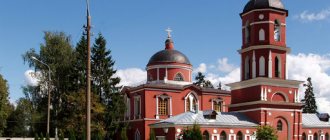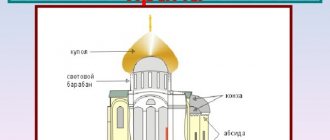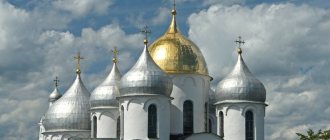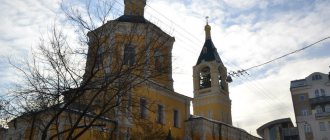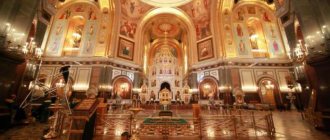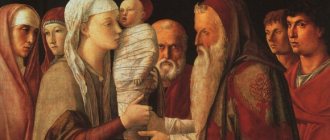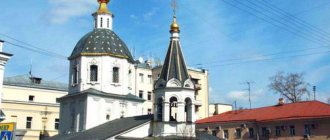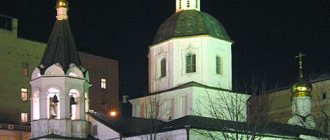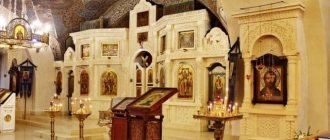The height of the Church of the Ascension in Kolomenskoye is 62 meters, the height of the tent is 20 meters. The area of the interior of the temple is 8.5 by 8.5 meters. The thickness of the walls in some places reaches four meters, in other places - two to three meters. Large bricks were used as building material. The unique foundation deserves special mention. This is a large artificial rock measuring 26 by 24 meters and a volume of three thousand cubic meters. A huge pit was dug on the slope of the river terrace, and its bottom was reinforced with piles. The monolithic foundation, which had different depths, was built from limestone blocks held together with mortar. The upper edge of the foundation can be seen on the surface of the hillside leading down to the river.
Few churches have gone through as many reconstructions and restorations as the Church of the Ascension in Kolomenskoye. The original decoration of its interior and paintings have not reached us. This is largely due to the fact that the temple was never heated in winter, and it was difficult to preserve the icons with frescoes.
Experts have put forward numerous versions of what the architecture of the church was and what its original appearance was. The history of the Kolomna Ascension Cathedral had to be restored literally bit by bit, but many secrets have not yet been revealed.
Apparently, the church was originally surrounded by a two-tier gallery covered with a “barrel” roof. Probably, the iconostasis in the first decades of the temple’s existence was single-tiered. The Moscow metropolitans, then (since 1589) the Patriarchs, sat in the “royal place” during ceremonial services.
The floor was covered with triangular white and black ceramic tiles. In the 1980s, part of a belfry was found on the southern porch, which existed until the 18th century. The grand ducal treasury could have been stored in the vast basement of the temple; it was brought to Kolomenskoye after its owner. Later the premises were used for economic purposes.
Characteristic features of the Old Russian Orthodox Church
Zakomara is a semicircular completion of the wall, repeating the outlines of the internal vault.
Kokoshniks are a false zakomara that does not follow the shape of the internal arch.
The light drum is the cylindrical end of the temple, the windows of which illuminate the interior.
The altar apse is a protrusion of the temple, oriented to the east.
The dome is a temple covering structure, similar in shape to a hemisphere.
The architect (presumably the Italian Petrok Maly) without hesitation rejected the canons of Byzantine monumentalism and turned to the elegant aesthetics of the Renaissance. Everything was new in the church. The absence of architectural elements traditional for Russian churches of an earlier period - zakomar, light drums - and the interior is modest in size, only 100 square meters. Instead of a traditional dome, the building ended with a polyhedron. Relying on the traditions of his native country, the architect, however, respected the experience of early ancient Russian architecture and used elements of wooden hipped churches.
Characteristics of style and construction features
The building is simply a collection of several architectural styles. There are pilasters with capitals in the style of the Early Renaissance, and Gothic vimpergs, and classic Russian kokoshniks. to understand what architectural style the architect adhered to .
Among the elements of the Renaissance are the following:
- order;
- portals with straight architrave ceilings of openings;
- drawing of Gothic vampires.
The height of the temple tower is as much as 62 meters. By the standards of those times, this was an impressive figure. The building was the tallest Orthodox building. And due to the flying architectonics, it feels like the building is floating above the ground.
The building has no internal supports, as well as the usual altar apse. It is installed on a basement surrounded by a walkway, and although the thickness of the walls is from 2 to 4 meters, from the outside the church looks very light. On the eastern side, the stone throne survived. The legs are made in the shape of lion paws, and the armrests are decorated with intricate arabesques. From here the Moscow rulers admired the immense expanse opening beyond the Moscow River.
The interior space of the building is not large, because it was the prince’s home temple. Only members of the sovereign's family and the closest, trusted servants could pray here.
The temple was built as a summer temple, unheated. There has never been a stove or any heating here. This is how he remains to this day. The Temple of the Ascension is considered the first tented temple made of stone. In addition, the church had the function of a watchtower. In the thickness of one of the walls there is a narrow staircase leading up straight to the tent. There is a special observation deck used for signaling. If a watchman stationed there saw suspicious movements or movements of troops, then a fire would immediately light up. At night it was a bright flame. During the day, the signal was given by smoke.
Characteristic features of a tent temple
Octagon (quadrangle) - polygonal base of the tent.
The tent is a multifaceted pyramid that serves to complete the temple.
After construction was completed, people came from different places to see the prayer church of the Rurik dynasty. They spoke of her as a miracle. “That church is wonderful in its height and beauty and lightness, such has never been seen in Rus' before,” a contemporary admired in the chronicle. Amazingly, the glory of the church will not fade despite the laws of time. More than three hundred years after its construction, the Parisian composer Hector Berlioz, after a visit to Moscow, would write: “Nothing struck me more in my life than the monument of ancient Russian architecture in the village of Kolomenskoye. I saw a lot, admired a lot, a lot amazed me, but time, ancient time in Russia, which left its monument in this village, was for me a miracle of miracles.”
Kolomenskoye has long been a part of Moscow; the church building has been repaired and rebuilt several times, but it has not lost any of its charm.
In the early 90s, the temple was included in the UNESCO World Heritage List, and in 2007, the ancient iconostasis with the royal doors was recreated and the church was re-opened to the public. Now people come here to look at exhibits in the church museum and listen to services on major holidays. Under the carved bell tower of the temple there was a terrace-gulbische, which was later turned into a gallery. Grand dukes once walked along the three covered staircases, but now everyone can rest here.
Church of the Ascension of the Lord in Kolomenskoye
The ingenious Church of the Ascension in the village of Kolomenskoye is one of the few surviving monuments from the era of Ivan the Terrible in Moscow. And in the urban planning model of the medieval “Third Rome,” Kolomenskoye was a symbol of the very Mount of Olives on which the Ascension of the Lord took place.
"For the sovereign"
Church of the Ascension of the Lord in Kolomenskoye
According to legend, the history of the village of Kolomenskoye began in 1237, during the time of Batu’s invasion. Legend has it that at that time the inhabitants of the town of Kolomna fled from the terrible khan from their devastated city closer to Moscow and allegedly even wanted to take refuge within the walls of the Kremlin, but it was already occupied by Muscovites. And then the refugees set up the settlement of Kolomninskoye on the southern outskirts of the Mother See, on the high bank of the Moscow River, named in memory of their destroyed city. Then it began to be called simply Kolomenskoye.
Indeed, the name of the village of Kolomenskoye comes from the name of the city of Kolomna. But the origin of the name of the city itself, both legends and numerous versions of scientists, explain differently. Most likely, this is a hydronym from the Kolomenka River. Or it came from the word “quarry”, where building stone was then mined. Or from the word “well”, meaning a dungeon where prisoners languished in the stocks. Or even from the noble Italian family Colonna: supposedly its representative, Charles Colonna, fleeing the persecution of the Pope, begged land from the Russian sovereign, founded an entire city on it and named it after himself. It is usually believed that the name Kolomna is based on the Finno-Ugric word “kolm”, meaning burial ground or cemetery, or the Slavic word “kolomen”, that is, “neighborhood”, “surroundings” (“about”), which was quite suitable for Kolomna near Moscow, and for Kolomenskoye.
The village of Kolomenskoye was first mentioned in 1339 in the spiritual letter (will) of Prince Ivan Kalita, which he drew up before his next trip to the Horde (no one knew then what the prince would return with or whether he would return). At that time, Kolomenskoye was already listed as “the sovereign’s”, that is, it was listed as the patrimonial possession of the Moscow princes. It was truly a paradise with water meadows and picturesque surroundings, where the Grand Duke’s and then the Tsar’s summer residence was located for several centuries. In the same 14th century, the first wooden princely palace was built with a facade facing the Moscow River.
Prince Dimitry Donskoy stopped in Kolomenskoye to rest with his army, returning from the Battle of Kulikovo: here jubilant Muscovites greeted him with honor, bread and salt, “honey and sables.” According to legend, he then founded a thanksgiving wooden church here in the name of St. George the Victorious, the patron saint of the princely family and the Russian army, near which the soldiers who died on the return journey and were wounded on the Kulikovo Field were buried. According to another version, this church was founded in honor of the joyful meeting of the victorious prince.
The village of Kolomenskoye itself was then still insignificant. Ivan III especially fell in love with this place and established a permanent residence in it. And only since the reign of Vasily III, who loved to “live” here and played an exceptional role in the fate of Kolomenskoye, has the village experienced the beginning of its heyday. The most august residents of Kolomenskoye became the customers of its churches. The peculiarity of Kolomenskoye is that its monuments cannot be considered separately. Only together they form the historical phenomenon of Kolomenskoye, which contains many mysteries and secrets, capturing the most fateful and dramatic events of Russian history.
"And all the beauty under heaven"
It is believed that after the wooden St. George Church, the first stone church appeared here - in honor of the Beheading of John the Baptist, in Dyakovo - on a high hill, separated from the rest of Kolomenskoye by a deep ravine. (It is interesting that in this place in the 19th century the oldest archaeological culture in Moscow, the Dyakovo archaeological culture, a primitive settlement from the Stone Age, was discovered.)
The delightful Church of the Baptist, dating back to the 16th century and revered as the architectural predecessor of the Church of the Intercession on the Moat on Red Square, holds many mysteries. According to traditional opinion, it was founded by Vasily III in 1529 as a prayer and votive temple for the birth of an heir, whom the Grand Duke had been waiting for more than 20 years and for the sake of which he decided to take an unprecedented step at that time - an official divorce from his first wife, Solomonia Saburova. She was forcibly tonsured in the Moscow Nativity Monastery, and she, according to legend, cursed her ex-husband, his new marriage, and all his offspring for this. But in Vasily III’s second marriage to Elena Glinskaya, there were no children for several years. In the winter of 1528/1529, the grand ducal couple traveled to monasteries with a prayer for the granting of an heir, but the couple did not receive what they asked for until they turned in prayer to the Monk Paphnutius of Borovsky.
Grand Duke Vasily III began building prayer churches to St. John the Baptist long before the birth of his son. Their dedication was associated with the namesake of Ivan Kalita, the ancestor of the Moscow Grand Dukes: thus Vasily III prayed for the gift of an heir, whom he promised to name John in honor of his great ancestor. After the birth of a son in 1530, who was actually named John, churches of St. John the Baptist were built in honor of his name day.
It is traditionally believed that in 1529, Vasily III, in commemoration of prayer for his son, built the multi-altar Church of the Baptist in Kolomenskoye. The main altar is dedicated to John the Baptist, which symbolized the sovereign’s desire to have an heir, the namesake Ivan Kalita. The prayer for conception was expressed in the dedication of one of the chapels to righteous Anna, the mother of the Most Holy Theotokos. Another chapel is dedicated to the Apostle Thomas, who at first did not believe in the Resurrection of Christ, which symbolized the awareness of the sovereign, who had no offspring, of the sinfulness of unbelief and doubt. The dedication of another chapel to Metropolitan Peter, the patron saint of the Kalita family, marked a prayer for the sending of a miracle. The next altar was consecrated in honor of Equal-to-the-Apostles Constantine the Great and his mother Elena, which symbolized a prayer to the heavenly patroness Elena Glinskaya.
On August 25, 1530 (Old Art.), on the eve of the memory of the Beheading of St. John the Baptist, the long-awaited heir, the future first Russian Tsar Ivan the Terrible, was born. In honor of the birth of his son, Vasily III ordered the construction of several Baptist churches in Moscow the following year, 1531, including the famous Ioannovsky Monastery on Kulishki. The main of these thanksgiving churches was the Church of the Ascension in Kolomenskoye, consecrated in 1532.
However, the mysteries of the Forerunner Temple are just beginning. This is undoubtedly a memorial church, that is, erected to commemorate some event, but what - now historians doubt the definite answer. Modern versions of scientists are divided into the above-mentioned early one - the temple was built as a prayer to Vasily III for the birth of an heir, and the later one - the temple was built by Ivan the Terrible himself, who loved Kolomenskoye no less than his father, and was dedicated to his heavenly patron. It could have appeared in memory of the wedding of Ivan Vasilyevich to the throne in 1547, although in honor of this event the Petroverigsky Church on Maroseyka was built in Moscow (the wedding took place on the Feast of the Adoration of the Chains of the Apostle Peter), from which now only the name of Petroverigsky Lane remains. Among other reasons for the construction of the Baptist Church in Kolomenskoye, they name the capture of Kazan in 1552, and a prayer for the granting of an heir - Tsarevich John Ioannovich, and thanksgiving for his birth, and even repentance for his murder. Another ancient legend says that the Forerunner Church was built by the same architects Barma and Postnik who erected the Cathedral of the Intercession on the Moat, which not only refutes the famous legend about the blinding of the masters, but also gives it a different meaning: when the king asked whether they could build a temple better, they answered that they could - and built a new miracle in Kolomenskoye. (If only the Church of the Baptist was actually built in the 1550s.)
But still, most scientists are inclined to the traditional version about the temporary priority of the Baptist Church over the Ascension Church and that it became the predecessor of the Intercession Cathedral, a kind of architectural experiment, where for the first time several side churches were united around the central temple. If the supporters of the later version are right, then the Church of the Baptist was the home church of the family of Ivan the Terrible, whose birth was so gratefully commemorated by the Church of the Ascension in Kolomenskoye.
The same debates are ongoing about the reason for the construction of the Church of the Ascension. Others believe that it could have been built by Vasily III not as a thanksgiving, but as a votive temple (if the Church of the Baptist was built later). Others even believe that the Ascension Church had nothing to do with the birth of the heir, but was built by Vasily III in gratitude for the victory over the Crimean prince Islam-Girey, won in 1528. The majority is inclined to the generally accepted version that the Ascension Church is a thanksgiving church, erected after the birth of the future tsar, which was accompanied by signs that greatly frightened Muscovites - a thunderstorm with lightning and even an earthquake.
The second line of dispute is the name of the architect of the Ascension Church. Some call him “unknown,” but undoubtedly a Russian master. Others - and the majority of them - consider him the architect of the Italian architect Petrok Maly, who built the fortress wall of Kitai-gorod in Moscow and the palace of Vasily III in Kolomenskoye in the same 1530s. Previously, the Kolomna Church of the Ascension was mistakenly attributed to Aleviz Novy, who built the Archangel Cathedral in the Kremlin. The architectural elements and technique of the Ascension Church indicate that its author was familiar with Italian architecture. After all, at that time the “great construction projects” of the Italians in Moscow were still going on, where they were nicknamed “Fryazins”: not accustomed to Russian frosts, they complained in their own language: “Fre! fre!” - "Cold". Petrok the Small, despite his masterpieces, had no luck in Russia. From the “great rebellion and statelessness” that began after the death of Elena Glinskaya in 1538, he fled to Livonia, he was sent to Dorpat to be tried by the local bishop, who decided to hand over the fugitive to the Moscow prince. What fate befell him in the future is unknown. After all, he knew many secrets of the Moscow fortresses, which the Russian sovereigns did not want to divulge.
To understand the symbolic and architectural phenomenon of the Ascension Church of Kolomensky, one should turn to the canons of the urban planning model of medieval Moscow, which conceived itself as the “Third Rome”, and the only heir of Byzantium, and God’s chosen power, called upon to preserve the Orthodox Church, and the center of world Orthodoxy. Medieval Moscow reproduced in its urban planning the symbols of the main Christian civilizations - Jerusalem, Constantinople, Rome, of which it felt itself to be the successor, and the image of the City of God from the Revelation of John the Theologian. Moscow was meaningfully arranged as an architectural and urban planning icon of the City of God - Heavenly Jerusalem - and was likened to the image of the Holy Land, associated with the earthly life of the Lord Jesus Christ.
In this urban planning model of the “Third Rome”, Grand Duke Kolomenskoye was given a special role - to symbolize the Jerusalem Mount of Olives, on which the Ascension of the Lord took place. The largest Orthodox researcher of medieval Moscow, M.P. Kudryavtsev, noted that in Moscow, unlike Jerusalem, this urban planning axis developed not to the East, but to the south - from the Kremlin to Kolomenskoye through Zamoskvorechye, which in turn was an image of the Garden of Gethsemane. And the very architecture of the snow-white, slender, crystal-faceted Kolomna Church, soaring into the sky on the high bank of the Moscow River, symbolized the Ascension of the Lord.
In accordance with the Russian eschatological idea, the Kolomna Church of the Ascension was also a symbol of the Second Coming of Christ, which is expected there, on the Mount of Olives, where His Ascension took place. Moscow, which set itself up as the “Third Rome,” seemed to be preparing the way for the Lord. And so it turned out that in Kolomenskoye - the symbolic Mount of Olives of Moscow - it was the Ascension Church that was built, as in Jerusalem. There is a version that the temple in Kolomenskoye is located at the same distance from the Kremlin “a day’s journey” as the Mount of Olives is from Jerusalem. In medieval times, the expectation of the imminent end of the world was natural, and it could be expected precisely in the “Third Rome” as the last and only stronghold of world Orthodoxy after Russia realized its messianic idea. According to Moscow legend, a symbolic place was even prepared for the Lord in the eastern part of the Ascension Church.
Moreover, before the final construction of Ivan the Great under Boris Godunov, it was the Ascension Church in Kolomenskoye that was the tallest building in Moscow: its height was more than 60 meters.
The construction of such a symbolic temple in the Grand Ducal Kolomenskoye emphasized the role of the Moscow sovereigns and the entire Russian state as a stronghold and defense of the Orthodox Church according to the ideology of the “Third Rome”. The enormous height of the temple also determined the freedom of the internal space, which created a feeling of free ascension and eyes and souls directed to the sky.
“That church is wonderful in its height and beauty and luminosity, such has never been seen before in Rus',” an ancient chronicler wrote about it. The purpose of the Ascension Church to symbolize God's chosenness of Russia and the Russian idea corresponded to the new ingenious architecture of the temple, like an arrow rushing to heaven: a tent placed at the base of the temple instead of the traditional cross-domed churches that came to us from Byzantium. This was the first stone tented temple in Rus'. It expressed, firstly, the identity of Russia as an independent Orthodox civilization and, secondly, the very symbolic idea of the tent. If in cross-domed churches the Orthodox cross is the basis of the layout, the internal pillars mean the support (pillars) of the Church (that’s why images of saints were painted on them), and the traditional five-domed structure symbolizes the Lord Jesus Christ surrounded by the four evangelist apostles, then in a tented church the meaning is revealed otherwise. Since ancient times, since Old Testament times, the tent canopy has symbolized the holiness of the place over which it was erected. In the Christian tradition, a tent canopy as an image of Divine grace was erected over a sacred place, symbolizing its God-preservation and the grace of God descending on it. In tent-roofed church architecture, a canopy was erected both over the temple - the house of God and its altar, and over those praying in it, and in the Kolomna Ascension Church - also over the members of the grand ducal family, and especially over the heir born through fervent prayers.
Most importantly, the tented temple in Kolomenskoye was associated with the dedication of this temple near Moscow to the Lord and His Ascension and His blessed canopy, which He spread over Russia and Moscow, which conceived itself as the “Third Rome” and “New Jerusalem”. This is how the canopy in the Church of the Holy Sepulcher in Jerusalem, the main Christian temple in the universe, was symbolically interpreted in Russian architecture. The single-domed roofed temple symbolizes Christ as the Head of the Church, and the pillar-shaped tented temple seemed to itself become a pillar of the Church and faith. The tent of the Church of the Ascension, original and free, truly ascends into the sky, towards eternity, lifting the souls of those praying to God.
Some find in the tented church a negative feature of a break with tradition and even “the aspiration upward of a lonely, proud soul.” Others, on the contrary, see in it Russian prayer in stone - a new understanding of completely traditional ideas without any break with them. Sometimes the Ascension Church is compared to a powerful tree, rooted in the ground with strong roots, symbolizing the heavenly “tree of life” and the tree of the grand ducal family. After all, it was the Grand Duke’s order that gave birth to a new architectural form of the tent-temple, which Patriarch Nikon later fought against as a non-canonical phenomenon. And if the Church of the Ascension in Kolomenskoye was the first of the Russian stone hipped churches, then the last one preserved in Moscow, built in the hipped style before the decree of Patriarch Nikon in 1648, is the Church of the Nativity of the Virgin Mary in Putinki on Malaya Dmitrovka. Nikon, having banned tented churches, ordered a return to the Byzantine cross-domed church and demonstrated the required model in the Cathedral of the 12 Apostles in the Kremlin, built in his patriarchal residence. And from then on, tents were erected for a long time only over bell towers, and only at the end of the 17th century a new era began in the history of Moscow tent churches - the Naryshkin Baroque.
Researchers also argue about the sources of the tent-roofed architecture of the Ascension Church. Some unconditionally consider the tent to be a purely national style, born from wooden Russian architecture, but others see in it Italian, Polotsk, and even Tatar origins. This explanation is also interesting: as the Moscow population increased, temples were required that could accommodate more people, and internal pillars interfered with this, so architects tried to do without them, erecting the first pillarless temples, where the roof rests directly on the walls, such as a church Saint Tryphon in Naprudny.
The Church of the Ascension, which became the summer church of the Grand Dukes, was intended only for members of the august family (which is why its internal dimensions are relatively small) and was connected by a covered passage to the palace. It also had an important defensive significance - a watchtower from which watchmen received “telegraph” fire signals about danger from the Moscow region. With the help of torches or lit birch bark they were transferred further - to the Simonov Monastery and to the bell tower of Ivan the Great. After all, it was from the south that the greatest danger to the borders of Moscow was then threatened - Tatar raids.
In the same 16th century, a separate bell tower appeared, which became the belfry of the Ascension Church. In its lower tier, the throne was consecrated in the name of St. George the Victorious. According to legend, it was built on the site of the wooden St. George Church, which was erected by Dmitry Donskoy. There is a version that the construction of this bell tower also began under Vasily III in honor of the birth and namesake of his second son, Yuri (baptized George), born in October 1533. The slender, swift, high bell tower seemed to echo the Ascension Church in its architecture.
The truly wonderful Ascension Church was consecrated by Bishop Vassian (Toporkov) of Kolomna, the nephew of St. Joseph of Volotsky, who was especially close to the court of the Grand Duke, who confessed and administered unction to Vasily III on his deathbed and to whom Ivan the Terrible later turned for advice on how to govern the state. After the consecration, Vasily III generously donated the temple with precious vessels and icons in rich vestments, and arranged a feast in Kolomenskoye, which lasted three days. But the time of the death of the Grand Duke was not far off. After his death in December 1533, Kolomenskoye was left to wait for a new owner - Ivan the Terrible himself.
Ivan the Terrible loved Kolomenskoye. According to legend, he built a huge “pleasure” palace here and spent a long time enjoying the beautiful view from the gallery of the Ascension Church. Here, in Kolomenskoye, he assembled regiments before the campaign against Kazan, here he was informed about the capture of Astrakhan, here he loved to hunt. For a long time there were legends about treasures with countless treasures, which the formidable king allegedly took from the conquered Novgorod and hid them in the dungeons under the Ascension Church. And most importantly, perhaps it was in Kolomenskoye that his legendary library was kept. There was a legend that Ivan the Terrible imposed a curse: whoever gets close to his “Liberia” will go blind.
Miracles of Kolomna
The beginning of the “rebellious age” was as difficult for Kolomensky as for all of Russia. In the summer of 1605, the troops of False Dmitry I were stationed here. Just a year later he was killed by the rebel Muscovites. The impostor was first buried in the Poor Houses at the Pokrovskaya Zastava (now Taganskaya Street), but then his body was dug up and burned in the village of Kotly, which was located a mile from Kolomenskoye. And in 1606, the rebel Ivan Bolotnikov camped here, who, in the wake of unrest, led another impostor, “Tsarevich Peter,” supposedly the son of Tsar Theodore Ioannovich, to Moscow. From Kolomenskoye he set out on a campaign to Moscow, but government troops fought at the very walls of the capital and drove Bolotnikov back to Kolomenskoye, where he suffered a siege by “fiery cannonballs” and went to Kaluga.
After his accession, Mikhail Fedorovich Romanov immediately ordered the construction of a new palace church in Kolomenskoye in honor of the Kazan Icon of the Mother of God, who saved Rus' from unrest. It was built only under Tsar Alexei Mikhailovich, in 1653, and the consecration was timed to coincide with a memorable date: under the cross of the temple it was inscribed that it was erected in honor of the 100th anniversary of the capture of Kazan. It was under the “Quiet” Tsar that Kolomenskoye experienced its heyday: the famous wooden palace, a fabulous tower, was erected here, called the eighth wonder of the world by Simeon of Polotsk, who wrote: “Its beauty can be equaled / to Solomon’s beautiful palace.”
Sometimes it is even compared to the Palace of Knossos on the island of Crete. It had 270 rooms and three thousand mica windows, the painting of the choir was supervised by Simon Ushakov himself, and at the gate stood wooden lions covered with skins, rolling their eyes and roaring menacingly with the help of a skillful internal mechanism. Two more such lions stood on the sides of the royal throne and roared loudly as the ambassadors approached it. The palace was connected by a covered passage to the newly built Kazan house church, which had its own hierarchy of worshipers: the retinue prayed in the refectory, and those closest to them prayed in the temple in front of the iconostasis. With the liquidation of the palace in the 18th century, the Kazan Church became the parish church of the village of Kolomenskoye, and services under its arches were interrupted only in 1941–1942.
Here, in Kolomenskoye, Alexey Mikhailovich dealt with the participants of the Copper Riot in July 1662, when a crowd of thousands of Muscovites moved here demanding the extradition of the traitor boyars who had started a disastrous reform, which made money devalued. But the rebels were met by rifle regiments that arrived in time. There was also a special “petition pillar” on which petitions to the king were placed at a strictly allotted time, although other scientists believe that it was a pillar for a sundial, and petitions were placed to the king on a separate table specially set for that purpose. But it is known for sure that it was from here, from this royal residence, that the expression “Kolomenskaya Verst” came, as they jokingly call a tall, thin, lanky man. The fact is that when the royal road, magnificent for those times, was laid from Moscow to Kolomenskoye, new, huge mileposts of a previously unprecedented height were placed on it, and they were remembered by the people.
The very picturesque panorama of Kolomenskoye, natural and man-made, was designed to impress both foreign ambassadors and loyal subjects with the majesty of the royal residence, to symbolize the power, glory and idea of the great sovereigns of the Orthodox “Third Rome” - the Russian state.
According to legend, it was in Kolomenskoye that Peter I was born, which is why the poet A.I. Sumarokov pompously called Kolomenskoye “Russian Bethlehem” in his verses:
The greatness of Russia has shone in you; Europe saw the baby, whom you matured in swaddling clothes, on the city walls, And the ocean gave the waters under his region, The peoples of all the lands trembled from him.
However, there are several such “legendary” places associated with the birth of Peter the Great in Moscow - this is also the Kremlin, and Petrovsko-Razumovskoye, which supposedly received its name because of the birth of Tsarevich Peter Alekseevich there... Most historians are of the opinion that that this sovereign was born in the Kremlin, and spent his childhood in Kolomenskoye. He and his brother were brought here from the raging Moscow during the Streltsy riot of 1682, here under a huge shady oak tree he learned to read and write from Nikita Zotov. Here young Peter lived after a quarrel with Princess Sophia, conducted his maneuvers, sailed for the first time on small boats along the river to the Kremlin and the Nikolo-Ugreshsky Monastery, even in stormy weather, and assembled amusing regiments. He honored the tradition of Russian sovereigns and, returning victorious after the capture of Azov and the Battle of Poltava, stopped in Kolomenskoye before the ceremonial entrance to Moscow, as Dimitri Donskoy once did. The last time Peter visited Kolomenskoye was during the coronation of Catherine I. But his daughter, the future autocrat Elizaveta Petrovna, was actually born in Kolomenskoye. For the rest of her life she remembered the wonderful fruits from the Kolomna gardens, so she often ordered them to be delivered to her in St. Petersburg. To keep the berries fresh, they were generously sprinkled with grain.
The emperors did not immediately abandon the “grandfather’s” Kolomensky. At first, Catherine II fell in love with this “royal village of Moscow” very much, even ordered the miracle palace of Alexei Mikhailovich to be dismantled and built a new Catherine Palace with four floors, in which she wrote her famous order for the deputies of the Legislative Commission. Here she lived with her grandchildren Alexander and Konstantin. According to legend, they once secretly staged a duel in the deep ravine of Kolomenskoye. The future Emperor Alexander Pavlovich, like his great ancestor, also learned to read and write here, only under the cedar tree - this is how, according to tradition, the royal children were taught in the summer in the open air. Then Catherine II got bored, as she put it, “climbing mountains like a goat,” and during one such walk in Kolomenskoye, the empress set her sights on the neighboring estate of Black Mud, which then belonged to Prince Kantemir. Catherine bought Black Mud and renamed it Tsaritsyno. And her palace in Kolomenskoye was occupied by the French in 1812 and destroyed. The eminent architect Evgraf Tyurin built a new Alexander Palace, which was abolished due to disrepair at the end of the 19th century, and the royal residence here was never restored.
Kolomenskoye was also famous for its wonderful springs. An ancient legend says that along the bottom of a ravine in Kolomenskoye, St. George the Victorious was chasing a serpent on horseback. The horse's hooves hit the ground and springs with clean water miraculously opened under them, healing eye and kidney diseases and especially infertility in women. They say that one of Grozny’s wives was healed here... And since then, women have prayed in Kolomenskoye for the gift of offspring. One such spring next to the Church of the Ascension is called “Kadochka”: in the log house above it there used to be a wooden tub, from which Muscovites collected healing water in buckets - and there was enough for everyone.
Kolomenskoye suffered the main blow after the capital was moved to St. Petersburg. Over time, Kolomensky’s life changed: the oblivion of the old Moscow residence by the emperors had an effect. The spirit of pre-revolutionary capitalism did not escape him either, when magnificent orchards began to be rented out, the land was prepared for cutting into summer cottages, and the territory of the estate was given over to folk festivals and entertaining bear fights.
And only the Church of the Ascension remained a place of pilgrimage, continuing to amaze those who saw it. Composer Hector Berlioz recalled that the shock experienced by the Church of the Ascension overshadowed the impressions of the Milan and Strasbourg cathedrals. “Nothing struck me more in life than the monument of ancient Russian architecture in Kolomenskoye... Here the beauty of the whole appeared before me. Everything inside me trembled. This was a mysterious silence, a harmony of the beauty of completed forms... I saw an aspiration upward, and I stood stunned for a long time.”
Something great, wonderful, long-awaited was about to happen under the arches of this temple. History has indeed prepared the highest mission for this church, and the miracle of God dawned on Kolomenskoye. Here they greeted the coming revolution with the miraculous appearance of the Sovereign Icon of the Mother of God, which happened on that terrible day for Russia, March 2/15, 1917, when the sovereign abdicated the throne. The first spiritual rebuff to the dark times of Russian history was given right here, in the Kolomna Church of the Ascension.
The history of the phenomenon is well known: in February 1917, on the eve of the tragic events, peasant woman Evdokia Adrianova from a village neighboring Kolomenskoye had two wonderful dreams. In the first, she stood on the mountain and heard a voice saying: “The village of Kolomenskoye, a large, black icon, take it and make it red, then pray and ask for it.” The God-fearing peasant woman became timid and began to ask for an explanation of the unknown dream. A few days later she had a second dream: she saw a white church, entered and saw a Majestic Woman sitting in it, in whom she recognized with her heart the Most Holy Theotokos, although she did not see Her face. Having compared the two dreams and received communion, she went to Kolomenskoye and saw the very white church that she had dreamed about. The priest of the Church of the Ascension, Father Nikolai Likhachev, after listening to her, went with her in search of the image, but they found it only when they decided to go down to the basement and look at the icons stored there. When they discovered the largest icon, blackened with dust, and carefully washed it, the Sovereign image of the Mother of God was revealed, signifying that power in Russia had passed into the hands of the Queen of Heaven Herself.
There were several months left before the reign of the God-fighting Bolsheviks; news of the miraculous appearance of the icon spread throughout Russia. Crowds of pilgrims flocked to Kolomenskoye to venerate the miraculous image, from which the first healings began, then the icon was brought to the Marfo-Mariinsky monastery to Saint Elizabeth Feodorovna. Then she was taken to other churches, and only on Sundays did she stay in Kolomenskoye.
There is a version that this image previously belonged to the Ascension Convent in the Moscow Kremlin - Starodevichy. Before Napoleon’s invasion, everything valuable was hidden from the Kremlin, sent for evacuation, and they decided to hide the Sovereign Icon in Kolomenskoye, where by God’s Providence it remained until 1917. After the revolution and the closure of the Ascension Church, the icon was transferred to the neighboring St. George Church, and after its closure - to the storerooms of the State Historical Museum. Only on July 27, 1990, the Sovereign Icon returned to Kolomenskoye, to the Kazan Church that was then in operation. Thousands of people in the pouring rain were waiting for the shrine in Kolomenskoye... And when the icon arrived, the sun shone and in its rays the image returned to the temple. Tradition linked the return of the miraculous image with liberation from militant atheism and the salvation of Russia from theomachism. The very next year, the USSR ended its existence along with the fall of the power of the CPSU.
A joyful milestone in the history of the truly God-protected Kolomensky was the appointment of Pyotr Dmitrievich Baranovsky as director of the museum organized here, who became its real creator. In the first years of the revolution, the collective farm “Garden Giant” was already located on the territory of Kolomenskoye. All churches, except Kazan, closed in the 1920s. Baranovsky had to save not only Kolomenskoye, but also old Russia. He traveled around the country and collected the most valuable monuments, protecting them from destruction, took all the most valuable things from churches destined for demolition, and the staff of the Kolomna Museum then consisted of four people, including a watchman. This is how rescued monuments of wooden Russian architecture of the 17th century ended up here: a meadery from the village of Preobrazhenskoye, a gate tower from the Nikolo-Karelian Monastery, and even the house of Peter I from Arkhangelsk. According to the recollections of museum employees, Baranovsky himself more than once climbed a rope to the dome of the Church of the Ascension, and once fell and fell to the ground, but “rested.”
Baranovsky also opposed the active search for the “Liberia” of Ivan the Terrible. These searches intensified after the revolution, and archaeological searchers had government permission to do so. The mysterious library was then searched for everywhere it could supposedly be - in the Kremlin, and in Alexandrova Sloboda, and near the Cathedral of Christ the Savior, and in Kolomenskoye... Here excavations were carried out under the Ascension and Predtechenskaya churches: these dungeons were declared a search area because , they say, only deep underground could the library be reliably hidden from fires. Baranovsky, who was distinguished by his strong and sharp character, in turn turned to the authorities with a demand to ban the search by government decision, because the required excavation work threatened the most valuable architectural monuments and was in itself unsuccessful.
Now the Ascension Church is jointly owned by the Kolomna Museum and the Patriarchal Metochion, founded here in 1994. Two years after the creation of the courtyard, the Ascension Church was included in the UNESCO World Heritage List.
Secrets and legends of the Church of the Ascension
Place
The temple was built on the shore, where, according to legend, there flowed a spring that was considered miraculous. The high Kolomna church was supposed to become a symbol of the Mount of Olives, on which the Ascension of Christ took place. No wonder it seems that the bulk of the snow-white carved temple seems to be reaching into the heavens. In addition, next to the temple lie the boulders remaining from the temple, with one of which Saint Yegory allegedly knocked down the serpent.
Time
The most common version says that the temple was built in honor of the birth of Ivan IV. However, some historians believe that such a complex architectural structure could not have been created in just two years - from 1530 to 1532. According to this point of view, the church was erected several years earlier to pray for the childbirth of the grand ducal couple. According to another version, the Church of the Ascension was founded in gratitude for the victory over the Crimean prince Islam-Girey.
Library
There is a legend according to which the library of Ivan the Terrible was kept under the Church of the Ascension. A priceless collection of manuscripts was given as a dowry to Sophia Paleolog, who married Ivan III. Among the papers were kept the rarest copies of ancient authors, treatises on magic and natural science. Now the library is considered to have disappeared without a trace.
Who built the temple
The name of the talented architect who built the temple has not yet been established. It can be assumed that the architect was an Italian. Most historians believe that the church was built by the then little-known architect Petro Annibale. In Russia he had many names - Petrok Maloy, Pyotr Fryazin. And Vasily III’s invitation to Moscow in 1528 makes this version the most convincing. It was the surname Fryazin that convinced many that this was a certain Pskov architect who built many masterpieces of architecture in the Mother See. It's actually a nickname. All Italians in Rus' were called this way.
We are sure that you will be interested in an article describing the architecture and history of the creation of the Hagia Sophia Church in Kiev.
Shrines[edit]
- A piece of the holy relics of the Holy Great Martyr Catherine (the saint's memory is celebrated on December 7).
- A piece of the holy relics of the Holy Great Martyr Barbara (the saint's memory is celebrated on December 17).
- Icon of St. Spyridon with a piece of a slipper from his foot.
- Cross with a particle in the ark of the LIFE-GIVING CROSS.
- Icon of Saint Alexei, the man of God, with a piece of his holy relics.
- Icon of the Holy Blessed Matrona of Moscow with a particle of her holy relics.
- Icon of St. Nicholas of Myra with a particle of his holy relics.
- Icon of St. Vmch. St. George the Victorious with a piece of his holy relics.
- Temple icon depicting St. Philaret and Theodosius (in the middle is the Church of the Ascension of the Lord) with a particle of the holy relics of St. Feodosia.
- Icon of saints mcc. Nina, Anastasia, Victoria with a particle of the holy relics of MC. Victoria Kordubskaya.
- Icon depicting the saints St. Seraphim of Sarov and St. Paisius of the Holy Mountain of Athos.
Interior decoration
Despite its impressive size on the outside, the interior space is small, because the church was originally built for the princely family, as a home church. But the splendor of the interior makes you forget about the small halls and everything else.
The sun's rays stream through many windows and illuminate the already light walls. This play of light creates a feeling of vast space. The tent rising upward resembles a stairway to heaven. The walls are painted with biblical scenes in gilding.
The iconostasis these days is assembled from icons that were able to survive and be preserved, because during the entire existence of the temple it was reconstructed several times
Wonderful acoustics allow the voices of the singers to soar under the dome and return directly to the souls of the parishioners.
The Church of the Ascension in Kolomenskoye Selo today, as in the year of its creation, continues to amaze with its grandeur, individuality and harmony of beauty. Remaining a place of pilgrimage, the vaults of the temple give a feeling of great miracle and God's Grace.
